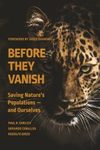About this book
Renewable energy is often simply termed "green energy", but its effects on wildlife and other forms of biodiversity can be quite complex. While capturing renewable resources like wind, solar, and energy from biomass can require more land than fossil fuel production, potentially displacing wildlife habitat, renewable energy infrastructure can also create habitat and promote species health when thoughtfully implemented.
The authors of Renewable Energy and Wildlife Conservation argue that in order to achieve a balanced plan for addressing these two crucially important sustainability issues, our actions at the nexus of these fields must be directed by current scientific information related to the ecological effects of renewable energy production. Synthesizing an extensive, rapidly growing base of research and insights from practitioners into a single, comprehensive resource, contributors to this volume
- describe processes to generate renewable energy, focusing on the Big Four renewables – wind, bioenergy, solar energy, and hydroelectric power
- review the documented effects of renewable energy production on wildlife and wildlife habitat
- consider current and future policy directives, suggesting ways industrial-scale renewables production can be developed to minimize harm to wildlife populations
- explain recent advances in renewable power technologies
- identify urgent research needs at the intersection of renewables and wildlife conservation
Relevant to policy makers and industry professionals – many of whom believe renewables are the best path forward as the world seeks to meet its expanding energy needs – and wildlife conservationists – many of whom are alarmed at the rate of renewables-related habitat conversion – this detailed book culminates with a final chapter underscoring emerging opportunities in renewable energy ecology.
Contents
Introduction: Renewable Energy and Wildlife Conservation, by Christopher E. Moorman, Susan Rupp, and Steven M. Grodsky
Part I: Bioenergy and Wildlife Conservation
1. Short Rotation Woody Crops and Wildlife Conservation, by Rachel Greene, James Martin, and T. Bently Wigley
2. Effects of Harvesting Forest-based Biomass on Terrestrial Wildlife, by Jessica A. Homyack and Jake Verschuyl
3. Impacts of Annual Crops for Biofuel Production on Wildlife, by Clint Otto
4. Second-Generation Feedstocks from Dedicated Energy Crops: Bioenergy for Heat, Fuel, Power and Bio-based Product Production, by Christine Ribic and Susan Rupp
Part II: Wind Energy and Wildlife Conservation
5. Wind Energy: Effects on Birds, by Regan Dohm and David Drake
6. Wind Energy: Effects on Bats, by Cris Hein and Amanda Hale
7. Emerging Issues in Wind-Wildlife Impacts and Mitigation: Underrepresented Wildlife Taxa, by Nicole Korfanta and Victoria Zero
Part III: Solar Energy, Waterpower, and Wildlife Conservation
8. Solar Energy: A Technology with Multi-scale Opportunities to Integrate Wildlife Conservation, by Brian Boroski
9. Waterpower: Hydropower and Marine Hydrokinetic Energy, by Henriette Jager and Lindsay Wickman
Part IV: The Future of Renewable Energy and Wildlife Conservation
10. Renewable Energy Policy Directives: Implications for Wildlife Conservation, by Ed Arnett
11. Renewable Energy Ecology: The Next Frontier in Wildlife Science, by Steven M. Grodsky, Sarah Fritts, and Rebecca Hernandez
Customer Reviews
Biography
Christopher E. Moorman is a professor, a university faculty scholar, and the coordinator of the Fisheries, Wildlife, and Conservation Biology Program at North Carolina State University. Steven M. Grodsky is a postdoctoral scholar at the University of California, Davis and the founder and co-director of the Wild Energy Initiative within the John Muir Institute of the Environment. Susan P. Rupp is the CEO of Enviroscapes Ecological Consulting, LLC.
Contributors:
- Edward B. Arnett
- Brian B. Boroski
- Regan Dohm
- David Drake
- Sarah R. Fritts
- Rachel Greene
- Steven M. Grodsky
- Amanda M. Hale
- Cris D. Hein
- Rebecca R. Hernandez
- Jessica A. Homyack
- Henriette I. Jager
- Nicole M. Korfanta
- James A. Martin
- Christopher E. Moorman
- Clint Otto
- Christine A. Ribic
- Susan P. Rupp
- Jake Verschuyl
- Lindsay M. Wickman
- T. Bently Wigley
- Victoria H. Zero







































